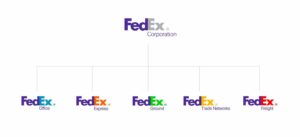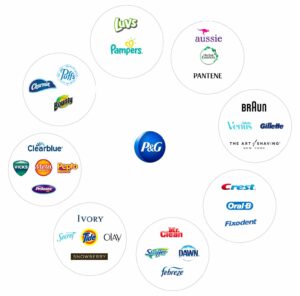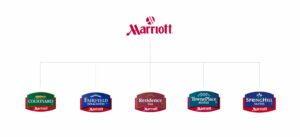Whether you have a startup or a well-established company that has existed for decades, clear brand architecture is important to its success. Imagine a house built by different architects and contractors who never coordinated with each other. The house would surely look like a patchwork of mismatched structures and designs – it would look ridiculous and confusing to say the least! The same holds true with unclear brand architecture.
Company brand equals company identity
Your company’s stakeholders, your customers, and the general public are likely to be confused if your brand architecture is not properly consolidated. That means your company’s brand architecture has both internal and external functions. Internally, it provides a sense of direction and boosts confidence and morale. Externally, it allows customers to easily identify your products and services; it helps establish trust and loyalty. Brand architecture establishes the identity of your brand and how your company relates to your customers. If that is unclear, then your company could experience an identity crisis.The unique identity of your company is not just about your logo, typography, core values, strategies, mission-vision, business units, and brand storytelling, but about how these various aspects are consolidated into a coherent whole.
What is Brand Architecture?
Throughout the lifespan of a company, it may expand and acquire other companies. As a result, its brand will evolve or other brands may be included in its list of products and services. Some companies may become multi-layered and multi-branded as they grow over time. Brand architecture is the way the subsections of your company are organized to reflect the larger brand.The way your company brand or brands can be understood is by the analogy of the various departments companies have. All companies have their own specialized departments such as:
- Human resources
- Marketing
- Product research and development
- Public relations
- Finance and accounting
- Legal
- Purchasing
- Production or manufacturing
These various departments have specific tasks and may have varying degrees of compartmentalization or autonomy. However, they must properly coordinate and communicate with each other to make the company function successfully. While they may have different functions, they are united in a common goal of sustaining the company and making it grow. In a similar way, the various sub-brands of your company may have their individual identities but they must all contribute to the identity and reputation of the main brand. For example, your company may sell different brands of computer games and applications but all these product brands must point out to the main brand. It must also be clear how each product brand works with the others within the same company. There are different ways of doing this. You can use one brand name with different products, such as those under Microsoft Office products (MS-Word, MS-Excel, MS-PowerPoint, MS-Publisher), or use unique brand names under one main brand, such as Nestlé’s brands – San Pelligrino, Nespresso, KitKat, Maggi, Hӓagen-Dazs, and Purina to name a few. In terms of structure, brand architecture can be organized based on product categories and how these categories relate to each other. These elements must be considered when designing brand architecture:
- Main brand identity
- Sub-brand categories
- Individual sub-brand identity
- Relationship with other sub-brands
- Interdependency of the sub-brands
- Hierarchical dependence on the main brand
Some product brands are interdependent and may be regulated by a central brand, for example the Microsoft Windows operating system. The program applications may vary in specific purposes but they are all consolidated by just one operating system.
How Brand Architecture helps address potential problems
In a similar manner that an operating system works by running program applications, defining the structure of your brand architecture will help you identify and address the following issues.
- Correct branding approaches such as stand-alone brands and master brand
- Various levels of branding that your company should use
- Types of sub-brands for each category and level
- Relationships and interdependency of the sub-brands
- Factors to consider when developing new brands
- Dominant versus recessive identities of brands
- Impact of the types of names that the company uses, whether coined, descriptive or generic descriptors
- Public promotions of specific features and benefits of certain brands or sub-brands
Different types of Brand Architecture
The history, type of company, and the products your company sells will determine the most appropriate type of brand architecture to use. There are three main types of brand architecture: corporate brand architecture, product brand architecture, and endorsing brands.
Corporate Brand Architecture
Corporate brand architecture means having one overarching brand with brand extensions that clearly link back to the main brand.Businesses typically offer either just one product or multiple products within the same category. For instance, if you have a restaurant, you will offer a variety of food on the menu but all of these are identifiable with your restaurant, especially if you start to franchise.For instance, McDonald’s has several franchised stores worldwide and each store offers the generic McDonald’s products such as burger and fries, but they may also offer country-specific products.The fast-food giant offers different and sometimes what we’d think of as weird food products elsewhere in the world. These include the French fries with maple BBQ sauce in Canada, the mashed potato burger in China, the shrimp beef burger in South Korea, and the pancake helado in Uruguay.On the other hand, different products that carry the same branding are common not only among fast-food chains but also among digital companies. Google, for instance, offers wide-range of apps such as Google Maps, Google Translate, and Google Cloud.Corporate brand architecture is ideal for a company that is focused on one product or one general category of products. But it is a different story when it comes to mergers and acquisitions.
Product Brand Architecture
Mergers and acquisitions are part of the growth trajectory of the majority of successful companies. This strategy of purchasing other companies to become subsidiaries of one big company assures diversification and resilience.Product brand architecture is when a parent brand is protected or separate from its brand extensions, which in turn are separate from each other.Companies that have acquired and merged with other companies over time will inevitably have a different and wide range of products. Some may be of totally different categories of products as the ones offered by the parent company. Product brand architecture is ideal for this scenario.This is the case with Google when it diversified and created the Alphabet Inc. multinational conglomerate. Originally, Google handled the various subsidiary companies but decided to return to being specialized as an internet-based company. The Alphabet Inc. conglomerate includes Google and other subsidiaries like X Development, Calico, Nest, Verily, Fiber, Makani, CapitalG, and GV.
The Endorsed Brand
A hybrid of the previous two types of architecture, endorsing brands is where sub-brands each have their own identity and can be associated with the master brand or not.Rather than having the master brand prominently displayed such as in Google apps, it is only secondary. An example of this is the Xbox gaming console, which is a product of the Microsoft Corporation.One main advantage of this type of branding is the credibility and prestige imbued by the parent brand while creating a unique identity for the product. In this manner, confusion as to what the product does is avoided. Nobody would confuse Xbox with a Microsoft program application. 
Benefits of being consistent with your brand architecture
Consistency builds trust and confidence. The credibility of your company is highly dependent on how it can consistently deliver high-quality services and goods.However, this credibility must be translated into a brand architecture that is easy to understand and immediately identifiable. It includes consistency in the typography, color motif, logo design, company mission-vision and motto, website design, brand storytelling, and marketing approach.Consistent brand architecture can help your company in the following ways:
- Clarity of identity in the marketplace – Customers will trust a brand that is consistent across the board. It provides clarity of identity in terms of how the products are related or how the sub-brands are connected to the trusted quality of the master brand. It also builds confidence among your company’s stakeholders.
- Establish a public persona with a compelling story – Every company has its own unique history and compelling story that may not be known to the public. Consistent branding can consolidate and emphasize the interesting story behind the company. This can help in creating a coherent overall strategy.
- Increase profitability – If you have a company with various product brands, having a coherent and consistent branding will help you increase profitability through cross-selling. Those who already trust a particular product brand of your company are likely to buy other product brands of your company if they understand the connections.
- Boost morale – Some companies encourage internal brand competition but this strategy is not a sustainable one, nor is it applicable to most types of businesses. Employees will be more motivated even if they belong to various business units if your company has a unified and clear branding.



